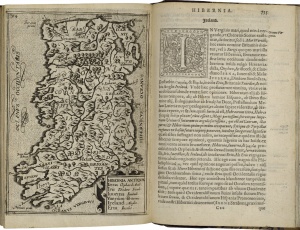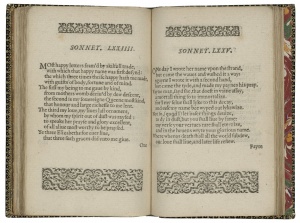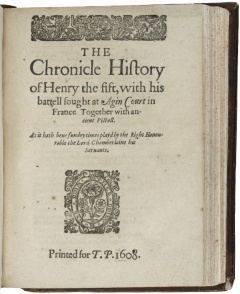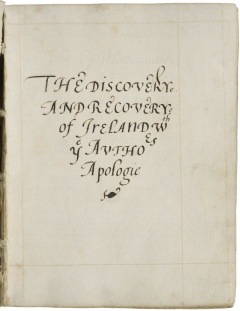Scholars' insights on Nobility and Newcomers in Renaissance Ireland
This article, part of Nobility and Newcomers in Renaissance Ireland, one of the Exhibitions at the Folger, offers modern insights Renaissance Ireland.
Through a selection of books, images, and manuscript materials, the curators tell a story of English-Irish relationships in the Renaissance that shifts the focus from conflict to influence and stresses each realm's international, mingled society.
Camden's Ireland (case 1)

Brendan Kane on William Camden's Britannica.
William Camden's Britannia was a run-away Elizabethan bestseller suggestive of English-Irish relations of the period. Camden was English—a historian, antiquarian, herald, schoolmaster, and eventually Oxford don. He enjoyed the friendship and support of the great Protestant leader and man of letters, Sir Philip Sidney, and was a major figure in the intellectual life of Elizabethan England. First published in 1586, the Britannia was a tour de force, an effort to use any and all sources he could find to tell the story of Britain and Ireland. These sources included ancient histories, archaeological remains, linguistic evidence, and the very landscape itself. Written in Latin, the book was intended to appeal to a broader European cohort of scholars.
This man who was so knowledgeable about England was, however, rather ignorant about Elizabeth's second realm: Ireland. While he traveled England doing first-hand research on his home kingdom, his Irish research relied on other people's accounts. That limited knowledge is suggested by a rather simple map. The section on England contains detailed regional maps, rather than a single one for the whole country. Moreover, there is much less text devoted to Ireland. The accompanying Latin, to the right of the map, starts off listing various names given to the island in antiquity. These are reproduced on the map itself in the lower right corner: in the left-hand column is the name of the island, and in the right of the people who use that name. For example, the natives called it Erin, while Aristotle and others called it Ierna. This is part of Camden's modern historical method: he does not trust a single ancient authority, but he gives the reader options. He also explains his own thoughts on the matter without presenting them as unvarnished truth. The Irish section of Britannia, then, suggests two basic if important points about Irish-English relations in this period: first, great interest by the English in a territory they claimed as part of their own; and second, the rather limited information they had on the place and its peoples. This, however, would change rapidly. Half-way through the seventeenth century, Ireland was among the most closely and frequently mapped places in Europe.
Listen to Kane discuss Camden's view of Ireland.
Brendan Kane is Associate Professor of History at the University of Connecticut and co-curator of this exhibition. In addition to teaching broadly in early-modern European history, he offers classes in Irish Gaelic. He is the author of The Politics and Culture of Honour in Britain and Ireland, 1541–1641 (2010) and co-curator of this exhibition.
Sidney in Dublin (case 2)
Thomas Herron on Sir Henry Sidney, Lord Deputy of Ireland.
John Derricke's Image of Irelande, is a long narrative poem published in London in 1581. It is a complex piece of propaganda that celebrates the militarized government of the three-time Lord Deputy of Ireland, Sir Henry Sidney, a noble newcomer to Ireland and father of the famous poet Sir Philip Sidney. It is one of the best-known books concerning Ireland in the period, not because of the quality of its verse—highly offensive by today's standards—but because of its extremely detailed and high-quality series of twelve woodcuts. These show, with great accuracy, details of English and Irish custom and costume.
The narrative and the woodcuts celebrate the campaigns of Lord Deputy Sidney against rebellious native Irish (or Gaelic) forces on the borders of the Pale, outside Dublin. In this woodcut, we see Sidney riding out of Dublin Castle across a moat to confront the enemy. A particularly gruesome detail is seen above the gate: it is lined with the severed heads of Irish rebels on spikes, which serve as trophies and a warning to others not to disobey their Lord Deputy. Their shaggy hair and unshaved faces indicate Irish ancestry.
Riding in front of Sidney is an entourage of well-equipped men. On their shields and flags we see the cross of St George, the national symbol of England. Another cross appears as the highest point on the horizon: this is the steeple of Christ Church Cathedral, a center of Protestant worship and administration in Dublin that still stands in greatly altered form today. Sidney, a Protestant governor, will ride past it on his way to fight the rebels in the countryside. The woodcut emphasizes the heroic nature of Sidney's reformation of the country, which he undertakes as a necessary enterprise for God and country, no matter how ugly the results.
Listen to Herron discuss woodcuts in Derricke's Image of Irelande.
Thomas Herron is Associate Professor of English at East Carolina University, Greenville, North Carolina and co-curator of this exhibition. He is the author of Spenser’s Irish Work: Poetry, Plantation and Colonial Reformation (2007) as well as co-editor (with Michael Potterton) of both Ireland in the Renaissance, c. 1540–1660 (2007) and Dublin and the Pale in the Renaissance, c. 1540–1660 (2011).
Ormond's bard (case 4)
Brendan Kane on Thomas Butler and the Irish language.
One of the exhibition features about which we are most excited is the display of Irish language materials. It is important to remember that Ireland was multi-lingual: Irish Gaelic, English and Latin are the obvious examples. It is also important to remember that the Irish language was not purely oral, but written and highly developed. Nor was Gaelic the preserve of Gaels alone; it was spoken and written by many Old English and even some New English. To demonstrate this, we present a facsimile of a Bardic poem and manuscript written in praise of Thomas Butler, tenth Earl of Ormond called “Toghaim Tomas rogha” on “Black Thomas” Butler. The poem, whose author unfortunately is unknown, is in the Bardic tradition of the battle roll, which praises the subject's military triumphs and general virtue. Although Renaissance-era Irish has much in common with present-day Irish, the sound and rhythm of Bardic poetry is quite different from today's spoken language. So that you may hear how this poem may have sounded to Ormond himself, we are lucky to have a selection read by Pádraig Breatnach, senior professor of The School of Celtic Studies at the Dublin Institute for Advanced Studies.
Listen to Kane discuss the Irish language and hear Pádraig Breatnach read a selection.
Tower Earl's lament (case 5)
Thomas Herron on Irish book ownership and James Fitzgerald.
Very few books exist today that are known to have been owned by Irishmen in the period: one fascinating book, an early sixteenth-century Venetian edition of works by the famous fourteenth-century Italian poet Francesco Petrarcha, is one of them.
As we can see from the inscriptions on the title page, it was owned by one of the most important political figures of his time, the Old English nobleman James fitz Gerald Fitzgerald, the sixteenth earl of Desmond. Fitzgerald had a miserable and unfortunate life. He was the son and heir of the fifteenth, "Rebel Earl", of Desmond, who died fighting the crown in 1583 and who lost his lands to the Munster Plantation as a result. The government eagerly suppressed the Desmond lordship so that their territory could be more easily appropriated, colonized and reformed. James, the sixteenth earl, despite being a thoroughly anglicized Protestant, was therefore kept locked up and powerless in the Tower of London for most of his short life and was known as the "Tower Earl." Because he was briefly propped up by the Crown as a puppet in Munster, in 1600, in the depths of the Nine Years' War, he also became known as the "Queen's Earl."
James Fitzgerald had refined tastes and plenty of time to read in the Tower. The book's ownership demonstrates how members of the Irish nobility, whether in England or Ireland, took a keen interest in European Renaissance culture. The book also demonstrates what is, apparently, an early example of Stockholm syndrome: Fitzgerald warmly inscribes the book to Beaupre Bell, his jail keeper in the Tower. Fitzgerald's inscription includes an intriguing motto that is cut off slightly at the edge; it reads, apparently, —Not as I would but as I may—a sad statement indeed given his highly limited circumstances.
Listen to the plight of James Fitzgerald.
Spenser love poems (case 6)

Thomas Herron on the influence of Ireland Edmund Spenser's poetry.
Edmund Spenser was one of England's greatest poets and also a mid-level New English administrator in Ireland for much of his mature career. Spenser advocated subduing the Irish by force of arms, colonization, and marshal law. The Irish had the last laugh, however, burning Spenser and his family out of house and home at Kilcolman on the Munster Plantation in 1598, during the Nine Years' War.
Despite his coarse politics, Spenser's poetry, in many different genres, was extraordinarily intelligent, sensitive, and refined. It, too, reflected Irish politics and, in a softer vein, described attractive Irish landscapes. In the following love poem to his second wife, included in his collection Amoretti and Epithalamion, whose title page is on display, Spenser woos his English bride by writing her name on a "strand," or beach, presumably in Ireland. Time will wash away the writing but not their love, which is immortalized in the poem, the 75th in the sequence. The sonnet shows a typical Spenserian fascination with mutability, or change, and the art's ability to overcome it. One can't help but think of Spenser's precarious state at Kilcolman, prone as it was to ruin and decay. The poem is read here by Professor Julian Lethbridge of Tuebingen University.
Listen to Herron discuss Spenser's poems and hear Sonnet 75 from Amoretti and Epithalamion read by Julian Lethbridge.
Queen Elizabeth (wall after case 6)
Thomas Herron on an unusual portrait of Queen Elizabeth I.
For half a century, this portrait of Queen Elizabeth I hung unheralded in a gift shop in eastern North Carolina. It was recently verified as authentic. Based on the sitter's appearance and other factors, the painting was dated to the mid-1590s, when the queen was in her sixties. It was likely painted in London by the studio of Marcus Gheeraerts the Younger. The original ownership of this painting, as well as how and why it survived the ravages of time, is a mystery.
Although the portrait could well have been a gift to a loyal servitor or an ambassador, it does not show the queen in her best light—the queen is on record for having ordered unflattering portraits of herself destroyed. The painting is highly unusual in portraying the queen as an aged woman, with "wrinkles and all." Note too the fine clothing and jewels that signal her regal status. The painting therefore opens a window on dynastic politics, including those involving Ireland. The queen's enemies were fond of slandering her as an illegitimate tyrant and heretic, daughter of Henry VIII's mistress Anne Boleyn, whose subtle wiles with the king caused his first divorce and helped usher in the Protestant Reformation to England. As Elizabeth herself aged she was cursed by Irish rebels, who were mostly Catholic, as a cailleach, or old hag. England and Ireland had had a long history of civil turmoil based on competing claims to the English throne, and the queen's age and infertility contributed to an ongoing anxiety.Her friends, simultaneously, were fearful of her aging, because her decision not to marry and produce an heir by the 1590s had imperiled the security of the realms. Should she die without a chosen successor, chaos might come again.
Listen to Herron discuss Queen Elizabeth I's image.
Shakespeare's Henry V (case 8)

Thomas Herron on similarities of Shakespeare's play and the Nine Year's War.
"Once more into the breach, dear friends!" This famous line from Shakespeare's Henry V is delivered by the English king outside the walls of Harfleur, the town in France besieged by the English for a month in 1415. It might just as well have been spoken by the second earl of Essex during his military campaign in Ireland in 1599, the year that Henry V is thought to have been written. Critics such as James Shapiro and others have long argued that the play, which centers on King Henry's famous campaign in France and miraculous victory at Agincourt, also promotes the campaign led by the earl of Essex to defeat Hugh O'Neill, earl of Tyrone, in Ireland during the Nine Years' War. The earl of Essex, Queen Elizabeth's favorite and already a military hero from previous expeditions abroad, was recruited to rescue the floundering English effort in Ireland. Campaigning with him as General of the Horse was Shakespeare's former patron, Henry Wriothesley, third earl of Southampton, whose portrait in later life can also be seen in this exhibit. Essex's campaign, despite some successful sieges, such as that of Cahir Castle in County Tipperary, was an expensive failure. Although ordered to destroy Tyrone, Essex instead made a truce with him. The queen was furious, and Essex's recall and political disgrace, and that of Southampton, soon followed.
The play, whose title page is seen here, does not record the later failures of Essex, but rather, refers to his hope for triumph. The Chorus to Act V, which was first published in the First Folio version of 1623, explicitly compares King Henry on his return from Agincourt to a modern-day "general" who, it is hoped, will come back to London from Ireland "with rebellion broached on his sword" on behalf of his "gracious empress," and to cheering crowds. If only Essex had been successful, he might well have captured England's heart as did Henry V.
Listen to Herron discuss the Nine Years War and Shakespeare's Henry V.
Captain Thomas Lee

Thomas Herron on Captain Thomas Lee.
This is the extraordinary portrait of English Captain Thomas Lee, who lived and fought with distinction in Ireland in the 1580s and 1590s, before his execution as part of the Essex rebellion in London in 1601. The painting. by Marcus Gheeraerts the Younger, is dated to 1596, during the Nine Years' War. It currently hangs in the Tate Gallery in London. Also on display in this exhibit you will find an influential political tract authored by Lee.
The portrait is one of the most iconic and bizarre images involving Ireland in the period. Lee represents himself as, literally, half-Irish and half-English. He holds in his right hand a light throwing spear, or dart, of the kind typically used by Irish foot soldiers, the so-called kern, whose light-footed hit-and-run tactics plagued the English armies. Lee's bare legs also imitate Irish fashion and attest to his fleet-footed athleticism. In contrast, Lee also holds an embossed helmet and wears a flowery, wide-sleeved shirt and vest in the English style, while placing his other hand on an ornately decorated pistol, a modern weapon used by both English and Irish. The pistol is carefully placed to once again emphasize his masculine power.
Lee's pose and clothing may echo theatrical custom, such as that used in masques and tilts at court, where his cousin, Sir Henry Lee, was the queen's champion: Tom Lee is trying to be sensational, even flamboyant.
But there is another, more serious story told by the painting: in the forest background is a body of water, which is meant to remind the viewer of Lee's military service at a ford in County Fermanagh the previous year. On the forest is written a Latin motto that derives from the ancient Roman historian Livy. It concerns Gaius Mutius Scaevola, a young Roman nobleman who infiltrated the camp of the enemy Etruscans and suffered heroically as a result. Captain Tom Lee, who fought valiantly on behalf of the English in Ireland, yet who negotiated at court on behalf of the Gaelic earl of Tyrone, is channeling the spirit of Scaevola. Lee makes a similar declaration of loyalty to his homeland while dressing, in part, like the enemy. Indeed, if you look closely at his left hand touching the gun, you can see the faint traces of a scar running across it that he received fighting in Ireland. Gaius Mutius Scaevola, similarly, had scarred his hand in service of Rome. Overall, the portrait demonstrates how English newcomers imitated Roman virtues, in renaissance fashion, and appropriated both cultures, English and Irish, in very public ways, according to the political circumstances at hand.
Listen to Herron discuss the portrait of Captain Tom Lee.
Praising King James (case 9)
Brendan Kane on an Irish poem in praise of James I.
Dia Dhuit—or hello. This exhibition includes a document that just might drastically alter your understanding of Irish-English relations in the Renaissance. We often think of the Gaelic Irish and the English monarchy as being in constant conflict. But Fearghal Óg Mac an Bhaird's poem Trà coróna i gcairt Sheamais, or Three Crowns in James's Charter, tells a rather different tale. Penned in 1603, it reinterprets the traditional Gaelic Inauguration poem, directing it to the Stuart monarch James I and welcoming him as the legitimate king of Scotland, England and Ireland. Mac an Bhaird not only bases his claim the authority of ancient books, but reinforces it through appeal to the ancient marriage metaphor of sovereignty. The poem depicts James as the spouse to the feminized island of Ireland. The piece is read by Pádraig Breatnach, senior professor of the School of Celtic Studies at the Dublin Institute for Advanced Studies.
Listen to Kane discuss a poem in Irish about King James I and listen to Pádraig Breatnach read the poem.
Thomond pedigree (case 12)
Brendan Kane on a pedigree of Gaelic nobility.
This is perhaps the most visually lavish pedigree of Gaelic nobility made in the time of the Renaissance. It was commissioned by Donough O'Brien, 4th earl of Thomond, and completed in 1614. As an O'Brien, the 4th earl was descendant of the greatest high king of Ireland, Brian Boru. He, however, was a staunch Protestant and chief ally of Elizabeth I and James I in the field and the Irish Parliament. He commanded forces against Hugh O'Neill during the Nine Years War, and later aggressively promoted the government's agenda in the House of Lords. But though he was a loyalist, he was no upstart, and this pedigree was one way in which he sought to remind people of his ancient lineage. According to Irish tradition, the gaels were descended of Spanish invaders—the sons of Mil—and beyond that to Greece. These ancient roots can be seen at the bottom of the page.
Thomond's real concern, however, was to trace his family and those closely connected to it. Near the top of the pedigree lie the present fortunes of various noble lines. Notice the little crowns which suddenly appear toward the top: these are actually coronets, the heraldic symbol of an earl. This depicts the transformation of Gaelic nobles into English-style ones. You can see Donough's green circle with coronet in the middle of the page, one row down. The pedigree offers other useful details, such as the one in a small yellow box at the upper left, which tells us that the McCarthy is imprisoned in the Tower of London. You are looking at a facsimile; the original is actually a fold-out in a large book that traces all these families individually—this being something like an index so that you can see them all together. And, indeed, the page numbers given throughout the pedigree tell you where in the book to go for more information on that particular person. This type of pedigree would have been available for guests and visitors to pore through and would have left no reader in any doubt as to which Gaelic family had the greatest lineage: the O'Briens—according to the earl of Thomond!
Listen to Kane discuss this elaborate pedigree for the O'Brien family.
The Kennedy Arcadia (case 13)
Brendan Kane on interesting literary English-Irish connections.
Fascinating English-Irish connections are revealed by the signed copy of The Countesse of Pembroke's Arcadia typically referred to simply as the Arcadia. Penned by the English literary giant and Protestant hero, Sir Philip Sidney, this pastoral romance was one of the great works of the English Renaissance. As you see at the bottom of the title page, it was printed in Dublin in 1621, and is the earliest known copy of fiction published in Ireland. The Irish capitol was thus well connected with literary fashions of the day, and from this date forward did not have to rely on imports from London but supported an active publishing trade of its own. Sidney also possessed strong Irish connections; he was the son of Sir Henry Sidney, Lord Deputy of Ireland under Elizabeth I. Philip spent time in Ireland and was a candidate for the Deputyship. Perhaps of greatest interest to English-Irish literary connections is the book's ownership. Just below the title you will see the signature of one Sylvester Kennedy, dated 1625. We have precious few details on the libraries of the Gaelic Irish, which makes this artifact exceedingly rare and valuable. Sylvester was most likely a student at Trinity College at the time, which suggests that he was a Protestant.
The book probably passed among members of the families, which we can surmise from the presence of two other signatures from family members, Mary and Robert, the identities of whom, however, are unclear. There was a Dublin alderman in the period named Robert Kennedy, who in spite of his political power and status, was imprisoned more than once for his Catholicism. Perhaps it was this Robert who signed the book? At this point, it's feasible to wonder whether these Kennedys are connected to our Kennedys? Unfortunately, that's not an easy connection to find. The family who owned this book is thought to have come from the gaelic Ui Cinneide in either Country Wicklow, or County Tipperary. Whatever their origin, they emerged as one of the most powerful and wealthy families in Dublin at the time, educated at the best schools, active in politics, and of both religious confessions—Protestant and Catholic. Whether our Kennedy dynasty descended from this one or not, the parallels between them are certainly striking.
Listen to Kane discuss a copy of Arcadia.
The London-woman (case 14)
Brendan Kane on Kerry poet Piaras Feiritear.
Gaelic poems were not given titles as such, but rather were known by their first lines. The first line of this work, by the Kerry poet Piaras Feiritear, tells it all. I gave my love to a foreign maiden. Love poems were, unsurprisingly, quite common. But what makes this one so curious is that the object of the poet's desire is an English woman of noble stock, one Meg Russell. Russell was related to the Earl of Bedford and Feiritear seems to have met her in the circle of the Earl of Cork. This poem is an example of attraction across all three social groups in the period. We have a poet of English Norman stock—Feiritear—who professes his love in Gaelic for a New English woman. But surely Russell knew no Irish. The poem then pays tribute, on a very personal and intimate level, to the possibilities and problems that stemmed from the interactions of English and Irish subjects. Social interaction in proximity might spark desire, but cultural differences and language gap could doom it to languish wistfully on the page. A selection is read by Pádraig Breatnach, senior professor of the School of Celtic Studies at the Dublin Institute for Advanced Studies.
Listen to Kane discuss Feiritear's poem to a New English woman and hear Pádraig Breatnach read a selection from it.